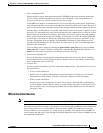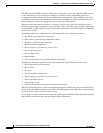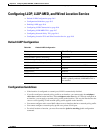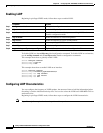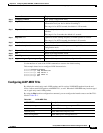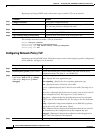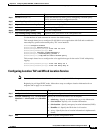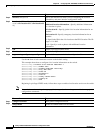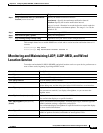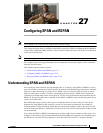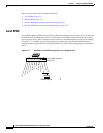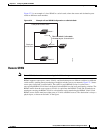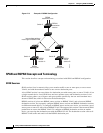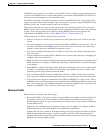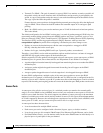
26-11
Catalyst 2960 and 2960-S Switch Software Configuration Guide
OL-8603-09
Chapter 26 Configuring LLDP, LLDP-MED, and Wired Location Service
Monitoring and Maintaining LLDP, LLDP-MED, and Wired Location Service
This example shows how to enable NMSP on a switch and to set the location notification time to 10
seconds:
Switch(config)# nmsp enable
Switch(config)# nmsp notification interval location 10
Monitoring and Maintaining LLDP, LLDP-MED, and Wired
Location Service
To monitor and maintain LLDP, LLDP-MED, and wired location service on your device, perform one or
more of these tasks, beginning in privileged EXEC mode.
Step 3
nmsp notification interval {attachment |
location} interval-seconds
Specify the NMSP notification interval.
attachment—Specify the attachment notification interval.
location—Specify the location notification interval.
interval-seconds—Duration in seconds before the switch sends the
MSE the location or attachment updates. The range is 1 to 30; the
default is 30.
Step 4
end Return to privileged EXEC mode.
Step 5
show network-policy profile Verify the configuration.
Step 6
copy running-config startup-config (Optional) Save your entries in the configuration file.
Command Purpose
Command Description
clear lldp counters Reset the traffic counters to zero.
clear lldp table Delete the LLDP neighbor information table.
clear nmsp statistics Clear the NMSP statistic counters.
show lldp Display global information, such as frequency of transmissions, the holdtime for
packets being sent, and the delay time before LLDP initializes on an interface.
show lldp entry
entry-name Display information about a specific neighbor.
You can enter an asterisk (*) to display all neighbors, or you can enter the
neighbor name.
show lldp interface [interface-id] Display information about interfaces with LLDP enabled.
You can limit the display to a specific interface.
show lldp neighbors [interface-id]
[detail]
Display information about neighbors, including device type, interface type and
number, holdtime settings, capabilities, and port ID.
You can limit the display to neighbors of a specific interface or expand the display
for more detailed information.
show lldp traffic Display LLDP counters, including the number of packets sent and received,
number of packets discarded, and number of unrecognized TLVs.
show location Display the location information for an endpoint.



